Stock Market volitility for April but should end the year Strongly Higher
Stock-Markets / US Stock Markets Mar 31, 2007 - 02:23 PM GMTBy: Adam_Oliensis
Dear Speculators,
We've been studying the 4-year cycle in the stock market for quite some time here. And over the past couple of weeks we've been entertaining two different hypotheses. Our working assumption had been that the 4-yr cycle low came before it was scheduled to in '06, forming in July and launching the new '06 - '10 cycle with the July-February rally from the 1220s up to the 1460 area.
This first chart plots the market's percentage gain off the July low (black line) against the median 4-year cycle performance since 1962 (blue line) as well as against the average performance (red line). The grey lines measure 1 standard deviation from the median. And the horizontal axis measures the number of trading days from the launch of the new cycle; this particular chart plots only the first 2 years of the cycle.
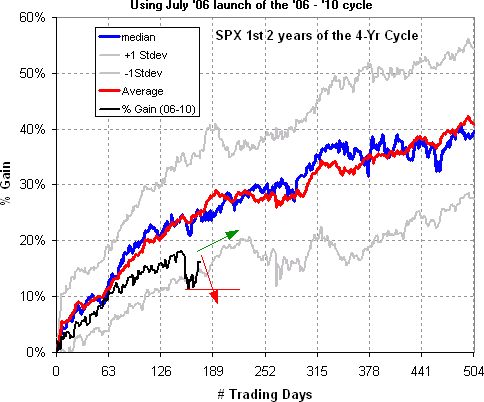
The black line had been moving along pretty much according to Hoyle, just a bit below both the median and mean lines until about trading day # 152, when the SPX dropped sharply all the way down to the -1 standard deviation line, from about +18% to +11%.
Now, that sudden, sharp drop on the black line came at a period when weakness was to be expected, as is visible on both the blue and red lines, but was much more sudden and sharp than I expected. And this variation from my expectation led me to hypothesize that it might be appropriate to shift what we consider to be the end date of the '98 - '02 cycle from October '02 to March '03, which in turn would shift the launch of the '02 - '06 cycle, and then the launch '06 - '10 cycle from July '06 to perhaps as late as April '07 (turning it into the '07 - '11 cycle).
Making that shift would change the plotting of the cycles so that the '03 - '07 would look more like this next chart in which the thick red line shows the course of this '03 - '07 progression.
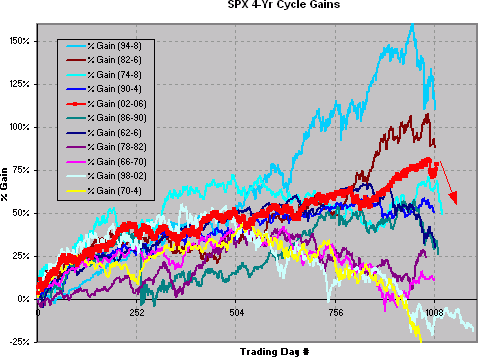
In this plotting of the current cycle, a precipitous downside continuation would be in store for the SPX between now and mid April, at which point a new 4-year cycle would begin.
Two very different scenarios, right? In the former scenario, the SPX would move to new highs from the early March sell-down, continuing in general to creep higher for roughly 3 more quarters before leveling out into a choppier trading pattern. And in the latter scenario, the SPX would tank hard into April before launching into the new 4-year cycle and a more aggressive uptrend that would most probably take the index up at least 25% during the remainder of '07.
But here's the curious part...
While the two scenarios are quite different in the near term, if we set our horizon for the end of 2007 we get very similar targets either way.
In the former scenario, if we assume that the SPX could rise to the +30% level by the end of '07 (6 quarters into the current cycle), which is to say 30% above the July '06 low near 1225, we get a year-end '07 target of about 1592.
In the latter scenario, if we look for the SPX to descend to the +55% area (that is, 55% above the March '03 low, or to 1240), and then to rally 25% off that +55% level in the subsequent 3 quarters, we get a target of about 1550.
1550...1592...close enough for government work.
So, whichever way the market goes during the next month, whether we get a precipitous sell-off to that takes the SPX down close to 200 points, or continued modest strength that keeps the market pushing ahead to new local highs, our cyclical work suggests that our original year-end target of 1550-1600 for the SPX is a sensible one.
Moreover, all this mathematical fiddling fits hand-in-glove with how the markets are reacting to the Fed's tinkering with its policy language. If the SPX were to suddenly drop 200 points, the Fed would probably be more likely to ease rates, which could easily set off market strength in 2H07. And if the SPX were to continue to creep higher, the Fed would be more likely to hold rates steady, which, at this point, would probably come as something of a disappointment to the stock market, somewhat muting its 2H07 advance.
There's always lots of talk about the "Greenspan Put" (and now the Bernanke Put), by which it is meant that the Fed Chairman has given the market confidence that if things get too bad, he'll loosen monetary policy, preventing a stock market crash. It's like the Fed has already bought put options on the stock market, or, functionally speaking, taken out insurance to prevent a crash.
I would submit that if we're going to give the market's anticipation of Fed policy a name that we should call it the Bernanke Collar. That is, it's like the Fed is short an out-of-the-money call (a call sold at a higher strike price) against the market and long an out-of-the-money put (at a lower strike price).
If the market goes up, then the Fed will hold rates or raise them. (There's a cap on the market, which is like being long stock and short a call.) And if the market goes down, then the Fed will lower rates, putting a floor on just how large a loss the market will incur (like owning a put as insurance).
So, what does this so-called Bernanke Collar look like? Let's look at one hypothetical collar using SPY stock as a surrogate for the SPX.
SPY is now at $143.39. Suppose we sold a Jan '08 155 call against a long position of 100 SPY. And then we turned around and bought a Jan '08 140 put. Using an implied volatility of 13, and a risk-free interest rate of 5.25%, here's what the position's risk/reward graph would look like at Expiration in January '08.
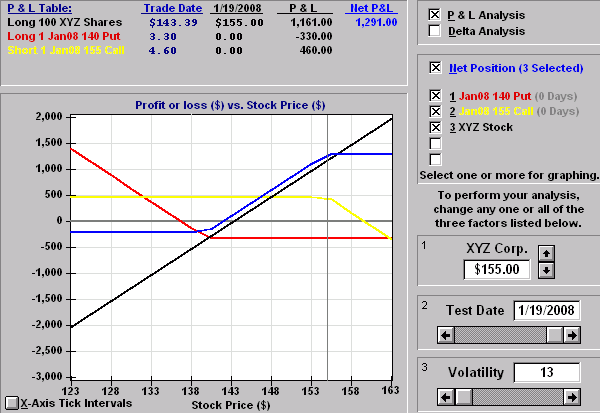
The black line on this chart shows what the gain/loss on a long position in SPY would look like at all the points between 123 and 163. The yellow line shows the value of the short 155 call. The red line shows the value of the 140 put. And the blue line shows the value of the net position (what we're calling for our purposes here the Bernanke Collar).
If we hold this Bernanke Collar position (blue line), our maximum downside at Expiration in Jan. '08 is $209 at SPY <=$140. Meanwhile at SPY >=$155 the maximum upside is $1291. And if SPY closes Jan. 19, 2008 right where it is now, the Bernanke Collar makes $131.
That's what a collar looks like. It has both limited downside risk and limited upside profit potential. And with the Fed in data-dependent mode, ready to raise rates if inflation grows too onerous and/or cut rates if growth becomes too anemic, I believe the Bernanke Collar is a more apt analogy at present than is the Greenspan Put.
Conceptually speaking, the Bernanke Collar ties in nicely with the cyclical study above, which suggests that whichever way the 4-yr Cycle plays out in the near term, our year-end '07 target of SPX 1550-1600 remains sensible.
As for last week's euphoric reaction to the FOMC's "lightening" of the tightening bias, the bond market's reaction makes the equity market's reaction look a little suspect.
While the Real Yield in the 5-Year Treasury Inflation Protected Securities (TIPS) market (red line below) did rise from a low of 1.99% to 2.03%, suggesting that expectations for economic growth had improved just a smidge from their worst recent levels, the Breakeven Inflation Rate rose even more to 2.49%, its highest level since August.
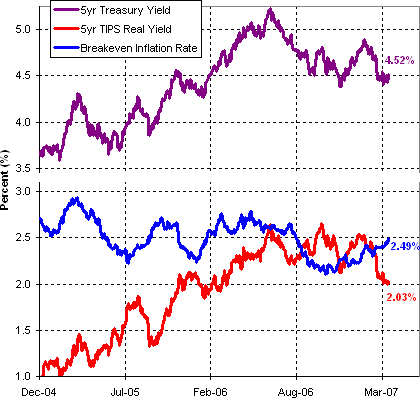
With the trend in growth expectations (red) falling and the trend in inflation expectations (blue) rising, it's tough to see what the market was so happy about last week. If anything, the Fed's (perhaps) less inflation-hawkish reference to "future policy adjustments" in their policy statement, which replaced the phrase "additional firming," may have itself INCREASED inflation expectations by virtue of the perceived diminished hawkishness of the phrase.
In this case the Fed might only be able to walk softly if they talk the talk of the hawk.
If growth expectations fall durably below 2% and/or if inflation expectations rise hard toward the 3% area, then the Fed is going to have some serious problems on its hands.
EARNINGS
The consensus estimate for growth in earnings continues to decelerate.
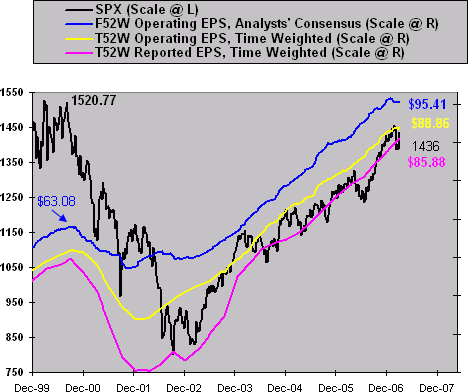
While earnings are at a very high level, over the past 3 months the growth in Forward 52-Week Earnings per Share (blue line, F52W EPS) has gone negative to the tune of a -1.6% annualized rate. And the expectation for F52W EPS relative to Trailing 52W EPS has shrunk to +7.4%, the lowest consensus for EPS growth since January 2002.
This past week there were declines in the F52W EPS consensus for the Energy, Financials, Information Technology, and Materials sectors.
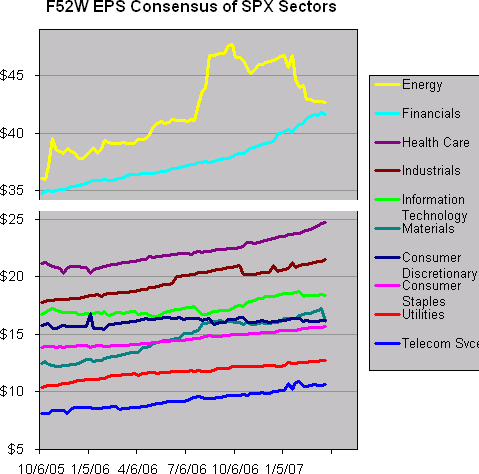
In general the established trends look healthy in the Financials, Health Care, Industrials, Consumer Staples, Utilities, and Telecom Services. But we should keep our eyes open for how these estimates may deteriorate in an environment of markedly slowing economic growth.
The progression in the consensus for F52W EPS continues to suggest that the Fed will remain on hold at least until the middle of this year. As you can see in this chart, both the Y/Y growth rate of F52W EPS (blue line) and the Y/Y change in the Fed Funds Rate (red line) are regressing toward their respective averages (7.5% and 0%).
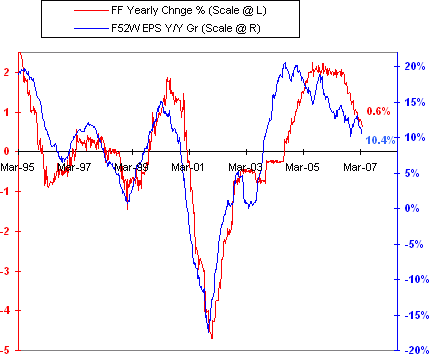
If the Fed remains on hold, the red line will hit 0% at the end of June. If earnings expectations fall sharply prior to that date, then maybe we'll see rate cuts before then. But it looks as though both the red and blue lines on this chart have rendezvous with neutral levels at around that time. And that we'll start getting a better take on '08 earnings estimates as well as on GDP growth prospects for 2H07 as spring turns into summer.
I continue to expect choppy trading into at least mid April and perhaps for another couple of months after that. It should take that long to digest the gains made from July through February. Once the picture for 2H07 clarifies, I expect the SPX to begin rallying toward our year-end target range as discussed above.
This past week traders in Agile Trader Index Options Service took profits of 23% on their QQQQ puts and 40% on their SPY puts. For a free one-month trial to Agile Trader Index Options Service click here.
Traders in Agile Trader Index Futures Service netted profits of 14.5% and 17.3% on their e-mini S&P futures positions and profits of 16% on their e-mini NDX futures positions. For a free one-month trail to Agile Trader Index Futures Service click here .
The above article was originally published at The Agile Trader on March 25, 2007.
Best regards and good trading!
By Adam Oliensis
Editor The Agile Trader
In 2007 the Agile Trader Index Options Service has closed trades for gross gains of +34%, +8%, +15%, and +31% for a gross total of +88% in position gains with no losing trades. In 2006 the System grossed +682% in position gains. (Of course, gross portfolio performance depends upon asset allocation.) If you would like to read more about The Agile Trader Index Options Service, CLICK HERE. And if you would like a free 1-month trial to the service (offered for a limited time), CLICK HERE and then click SUBSCRIBE .
After the Great Bear Market of 2000-2002 every single trader I knew from “back in the day” was wiped out. I got hurt too. Big time. The game had changed on so many different levels that everything I thought I knew turned out to be essentially useless. So, I started over. From scratch. I began to try to understand what was really driving the markets. I began the search for a trading model (or system) that would work in bull markets, bear markets, and trendless markets as well. I began the search for a system that would help to minimize the stress of trading too. Why? Because, the wild, emotional swings were taking their toll on my personal life, on my marriage, and on my relationships with my kids. And if our results using the Dynamic Trading System are any indication, we have found what we were looking for!
DISCLAIMER - All securities trading, whether in stocks, options, or other investment vehicles, is speculative in nature and involves substantial risk of loss. We encourage our subscribers to invest carefully and to utilize the information available at the websites of the Securities and Exchange Commission at http://www.sec.gov and the National Association of Securities Dealers at http://www.nasd.com . You can review public companies filings at the SEC's EDGAR page. The NASD has published information on how to invest carefully at its website. We also encourage you to get personal advice from your professional investment advisor and to make independent investigations before acting on information that we publish. Most of our information is derived directly from information published by companies or submitted to governmental agencies on which we analyze and/or rate from other sources we believe are reliable, without our independent verification. Therefore, we cannot assure you that the information is accurate or complete. We do not in any way warrant or guarantee the success of any action you take in reliance on our statements, ratings, or recommendations.
© 2005-2022 http://www.MarketOracle.co.uk - The Market Oracle is a FREE Daily Financial Markets Analysis & Forecasting online publication.



